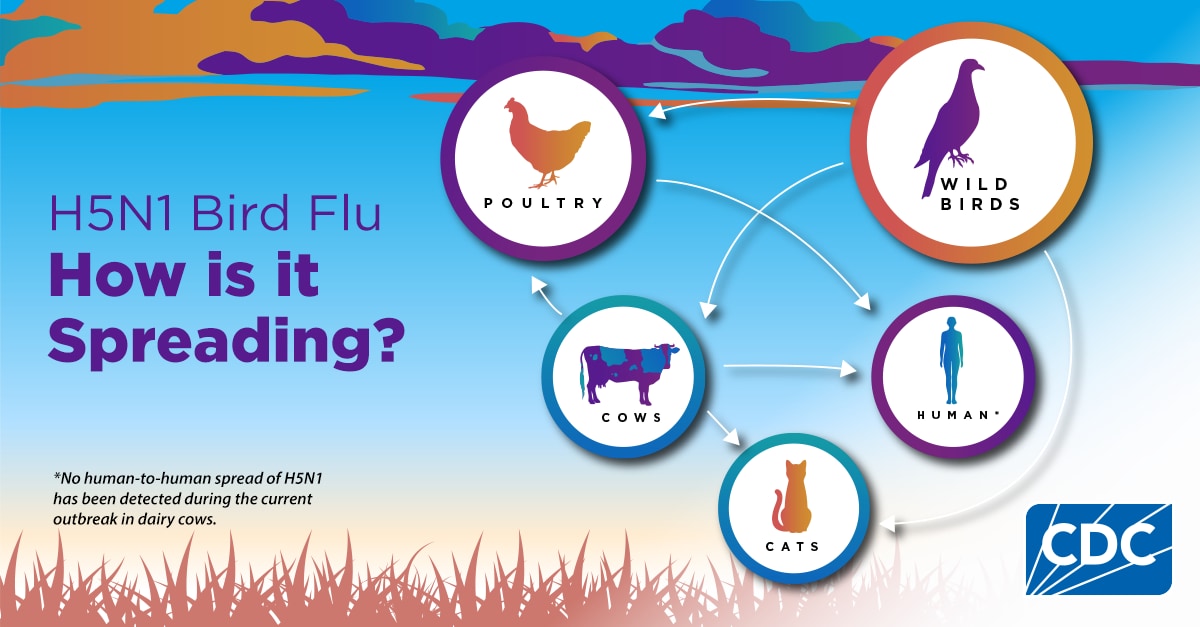What to know
- H5 bird flu is widespread in wild birds worldwide and is causing outbreaks in poultry and U.S. dairy cows with several recent human cases in U.S. dairy and poultry workers.
- While the current public health risk is low, CDC is watching the situation carefully and working with states to monitor people with animal exposures.
- CDC is using its flu surveillance systems to monitor for H5 bird flu activity in people.

Current situation
H5 Bird Flu Detections in USA
• Dairy cattle: Ongoing multi-state outbreak
• Wild Birds: Widespread
• Poultry Flocks: Sporadic outbreaks
• Mammals: Sporadic infections
• Person-to-person spread: None
• Current public health risk: Low
Confirmed human case summary during the 2024 outbreak, by state and exposure source
Exposure Source
| State | Cattle | Poultry | Unknown | State Total |
|---|---|---|---|---|
| California | 26 | 0 | 0 | 26 |
| Colorado | 1 | 9 | 0 | 10 |
| Michigan | 2 | 0 | 0 | 2 |
| Missouri | 0 | 0 | 1 | 1 |
| Oregon | 0 | 1 | 0 | 1 |
| Texas | 1 | 0 | 0 | 1 |
| Washington | 0 | 11 | 0 | 11 |
| Source Total | 30 | 21 | 1 | 52 |
NOTE: One additional case was previously detected in a poultry worker in Colorado in 2022.
Additional cases meeting the Council of State and Territorial Epidemiologists (CSTE) probable case definition have been reported by states: 1 case with dairy cow exposure (CA), 3 cases with poultry exposure (WA). Confirmatory testing at CDC for these cases was negative.
This table is typically updated by 5 PM EST on Mondays (for cases confirmed by CDC on Friday, Saturday, or Sunday), Wednesdays (for cases confirmed by CDC on Monday or Tuesday), and Fridays (for cases confirmed by CDC on Wednesday and Thursday). Affected states may report cases more frequently.
H5 Monitoring in People
National flu surveillance (since February 25, 2024)
Targeted H5 surveillance (since March 24, 2024)
Detections in Animals
- 10,563 wild birds detected as of 11/12/2024 | Full Report
- 51 jurisdictions with bird flu in wild birds
- 107,736,001 poultry affected as of 11/15/2024 | Full Report
- 48 states with outbreaks in poultry
- 508 dairy herds affected as of 11/15/2024 | Full Report
- 15 states with outbreaks in dairy cows
These data will be updated daily, Monday through Friday, after 4 p.m. to reflect any new data.
Cumulative data on wild birds have been collected since January 20, 2022. Cumulative data on poultry have been collected since February 8, 2022. Cumulative data on humans in the U.S. have been collected since April 28, 2022. Cumulative data on dairy cattle have been collected since March 25, 2024.
Protective Actions for People
- Protective actions around wild birds Avoid direct contact with wild birds and observe them only from a distance, if possible. Learn more.
- What to do if you find a dead bird Avoid contact with wild or domestic birds that appear ill or have died and call to report sick or dead birds. Learn more.
- Protective actions around other animals with H5N1 bird flu Avoid unprotected exposure to infected live or dead animals or surfaces contaminated by them. Learn more.
- Protective actions if you work with potentially infected dairy cattle Avoid unprotected direct physical contact or close exposure with cattle and materials potentially infected or confirmed to be infected with HPAI A(H5) virus. Learn more.
- Consuming Milk People should not eat or drink raw milk or products made with raw milk. Choosing pasteurized milk is the best way to keep you and your family safe. Learn more.
- Preparing food It is safe to eat properly handled and cooked poultry in the United States. There are recommendations around products from other animals with H5 virus infections, including cattle and milk. Learn more.
- Traveling to other countries CDC does not currently recommend any travel restrictions related to bird flu to countries affected by bird flu in birds, other animals or people. Learn more.
- If you have contact with infected birds or other animals and become sick Learn what to do if you have contact with infected birds or other animals and become sick. Learn more.
- Clinicians can visit CDC's avian influenza (bird flu) information for health professionals for the latest guidance. Learn more.
- Public health professionals and laboratorians can visit CDC's avian influenza (bird flu) information for public health partners for the latest guidance. Learn more.
- Get a seasonal flu vaccine Seasonal flu vaccination will not prevent infection with bird flu viruses, but can reduce the risk of getting sick with human influenza viruses and thus the risk for seasonal and bird flu co-infection. Learn more.
